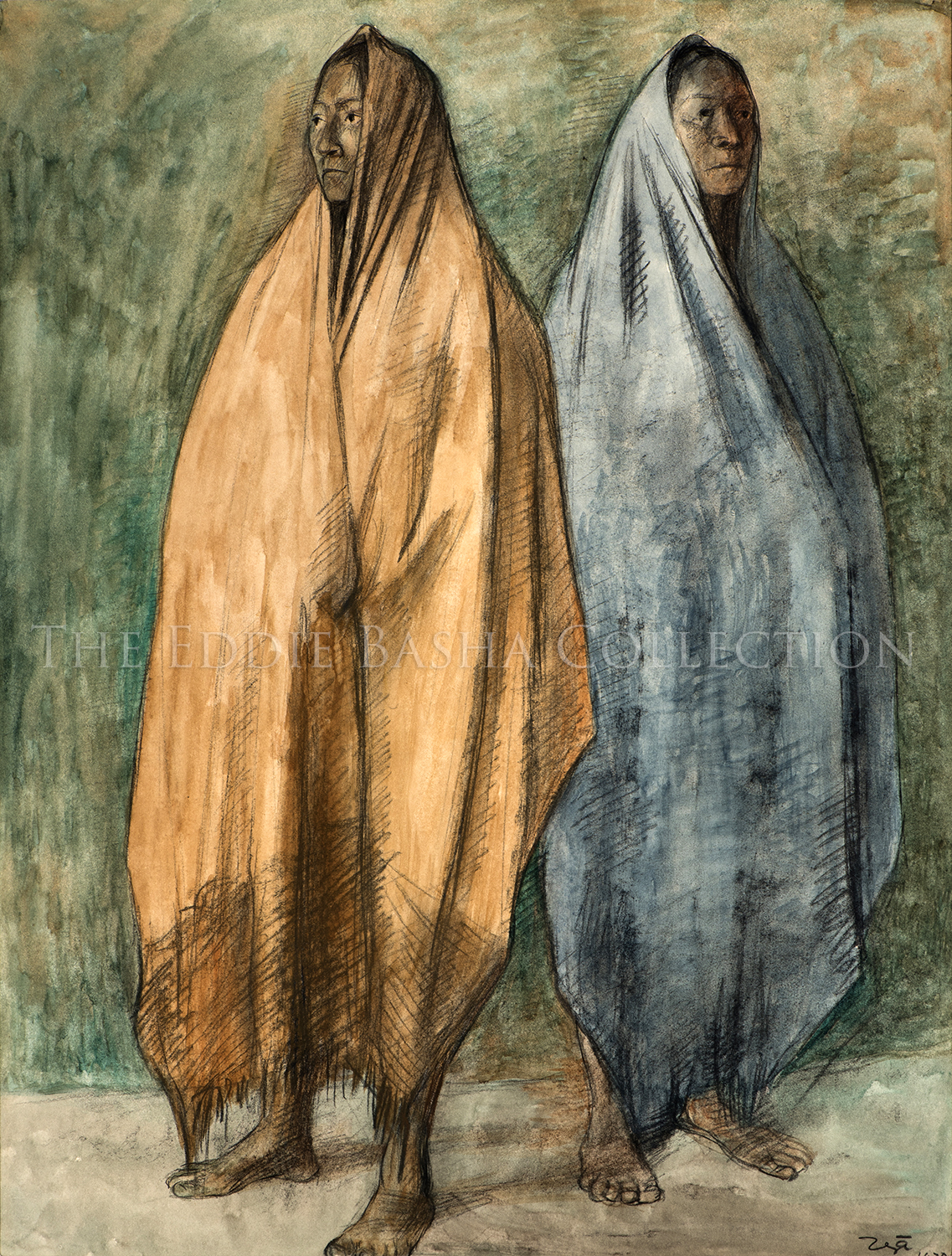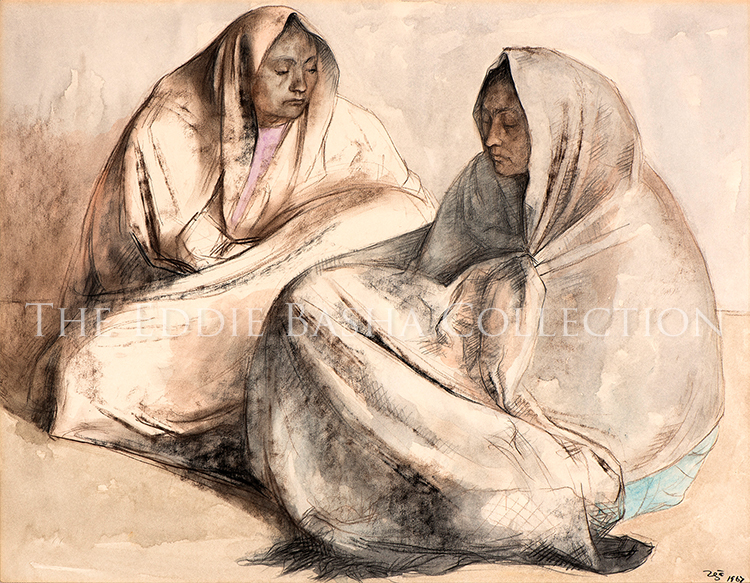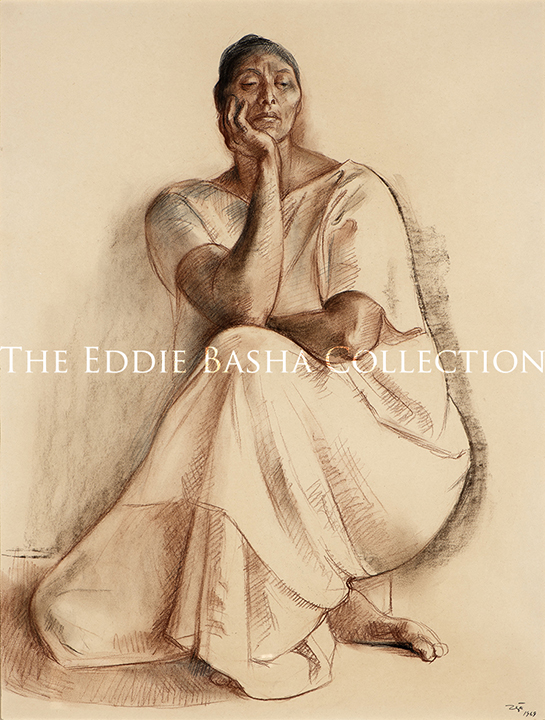
Francisco Zúñiga
(1912-1998)
Francisco Zúñiga was a Costa Rican-born Mexican artist best known for his stylized figurative paintings and sculptures. Zúñiga’s work often adopts qualities of pre-Columbian art, especially in his stone sculptures which strive to maintain a timeless, mysterious quality in their boldly simplified forms. Most of his work depicts female figures either as nudes within natural environs, or as contemporary women walking through the markets of Mexico. Born on December 27, 1912 in Barrio de San José, Costa Rica, both of his parents were sculptors. Zúñiga was deeply influenced by the German Expressionists and the sculptor Auguste Rodin early in his artistic development. Today, his works can be found in the permanent collections of the Metropolitan Museum of Art in New York, the Museo de Arte Moderno in Mexico City, and the Hirshhorn Museum and Sculpture Garden in Washington, D.C. The artist became a Mexican citizen 50 years after his arrival to the country, and died on August 9, 1998 in Tlapan, Mexico.
Source: artnet

Unknown Title
Artist: Francisco Zúñiga (1912-1998)
Description: Conte Crayon (1970) | Image Size: 25”h x 19”w;drawing
Framed Size: 34 3/4'h x 28w
This Zuniga work showing two women in their rebozos has simple lines though the overall use of color adds emphasis to each figure. Zuniga’s preference was to focus on the figurative aspects of art, in particular that of the human figure. In fact, he stated that the human figure was the most important aspect of the world around him. As a result, he spent much of his time drawing many of the women he encountered at various markets he frequented. He expressed that the female form represented maternity and familial responsibility according to his purview. And his body of work, drawings and sculptures, reflects that as it most often features women in various shapes, sizes, poses, at various stages of life, some with child or caring for one, in repose, observing others, in a time of reflection or even mid-task. A common thread throughout is the way in which Zuniga elevates the human form to the level he perceived it from and eliciting connectivity to the subjects without placing them within a specific environment or context.
A Costa Rican born Mexican artist, Francisco Zuniga’s work can be found the world over in private collections such as The EBC and in museums such as the Museum of Latin American Art, The Metropolitan Museum of Art, Harvard University, Phoenix Art Museum, Museum of Costa Rican Art, Museum of Modern Art Mexico
City, San Diego Museum of Art and the Hirshhorn Museum and Sculpture Garden in Washington, D.C. just to mention a few.
Title Unknown
Artist: Francisco Zúñiga (1912-1998)
Description: Conte Crayon | Image Size: 19”h x 24”wdrawing
Zuniga's skill at carefully composing a drawing that conveys depth and dimension is evident in this piece of two women draped in rebozos, long flat garments used mostly by Mexican women which can be worn in various ways either folded or around the head and upper body to shade from the sun, as warmth or as an accessory. It can also be used to carry babies and large bundles. By placing the figures as he has, with one behind and to the left of the other, Zuniga created an illusion that the women occupy three dimensions rather than two. Coupled with the repetitive shapes that flow into one another, a somewhat sculptural aesthetic has been achieved.
Long Haired Seated Woman
Artist: Francisco Zúñiga (1912-1998) Date: 1979
Description: Conte Crayon | Image Size: 19"h x 27"w; Framed Size: 27 3/4"h x 35 3/4"wdrawing
Seated Woman
Artist: Francisco Zúñiga (1912-1998)
Description: Conte Crayon (1969) | Image Size: 26”h x 20”w; Framed Size: 34 ½”h x 28”wdrawing
 Conte Crayon (1970) | Image Size: 25”h x 19”w;
Conte Crayon (1970) | Image Size: 25”h x 19”w;Framed Size: 34 3/4'h x 28w
This Zuniga work showing two women in their rebozos has simple lines though the overall use of color adds emphasis to each figure. Zuniga’s preference was to focus on the figurative aspects of art, in particular that of the human figure. In fact, he stated that the human figure was the most important aspect of the world around him. As a result, he spent much of his time drawing many of the women he encountered at various markets he frequented. He expressed that the female form represented maternity and familial responsibility according to his purview. And his body of work, drawings and sculptures, reflects that as it most often features women in various shapes, sizes, poses, at various stages of life, some with child or caring for one, in repose, observing others, in a time of reflection or even mid-task. A common thread throughout is the way in which Zuniga elevates the human form to the level he perceived it from and eliciting connectivity to the subjects without placing them within a specific environment or context.
A Costa Rican born Mexican artist, Francisco Zuniga’s work can be found the world over in private collections such as The EBC and in museums such as the Museum of Latin American Art, The Metropolitan Museum of Art, Harvard University, Phoenix Art Museum, Museum of Costa Rican Art, Museum of Modern Art Mexico
City, San Diego Museum of Art and the Hirshhorn Museum and Sculpture Garden in Washington, D.C. just to mention a few.
Unknown Title
Artist: Francisco Zúñiga (1912-1998)
Framed Size: 34 3/4'h x 28w
This Zuniga work showing two women in their rebozos has simple lines though the overall use of color adds emphasis to each figure. Zuniga’s preference was to focus on the figurative aspects of art, in particular that of the human figure. In fact, he stated that the human figure was the most important aspect of the world around him. As a result, he spent much of his time drawing many of the women he encountered at various markets he frequented. He expressed that the female form represented maternity and familial responsibility according to his purview. And his body of work, drawings and sculptures, reflects that as it most often features women in various shapes, sizes, poses, at various stages of life, some with child or caring for one, in repose, observing others, in a time of reflection or even mid-task. A common thread throughout is the way in which Zuniga elevates the human form to the level he perceived it from and eliciting connectivity to the subjects without placing them within a specific environment or context.
A Costa Rican born Mexican artist, Francisco Zuniga’s work can be found the world over in private collections such as The EBC and in museums such as the Museum of Latin American Art, The Metropolitan Museum of Art, Harvard University, Phoenix Art Museum, Museum of Costa Rican Art, Museum of Modern Art Mexico
City, San Diego Museum of Art and the Hirshhorn Museum and Sculpture Garden in Washington, D.C. just to mention a few.
 Conte Crayon | Image Size: 19”h x 24”w
Conte Crayon | Image Size: 19”h x 24”wZuniga's skill at carefully composing a drawing that conveys depth and dimension is evident in this piece of two women draped in rebozos, long flat garments used mostly by Mexican women which can be worn in various ways either folded or around the head and upper body to shade from the sun, as warmth or as an accessory. It can also be used to carry babies and large bundles. By placing the figures as he has, with one behind and to the left of the other, Zuniga created an illusion that the women occupy three dimensions rather than two. Coupled with the repetitive shapes that flow into one another, a somewhat sculptural aesthetic has been achieved.
Title Unknown
Artist: Francisco Zúñiga (1912-1998)
Zuniga's skill at carefully composing a drawing that conveys depth and dimension is evident in this piece of two women draped in rebozos, long flat garments used mostly by Mexican women which can be worn in various ways either folded or around the head and upper body to shade from the sun, as warmth or as an accessory. It can also be used to carry babies and large bundles. By placing the figures as he has, with one behind and to the left of the other, Zuniga created an illusion that the women occupy three dimensions rather than two. Coupled with the repetitive shapes that flow into one another, a somewhat sculptural aesthetic has been achieved.